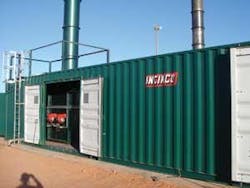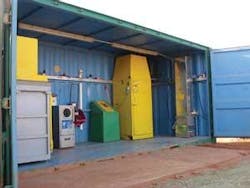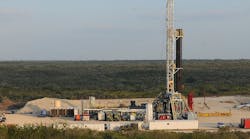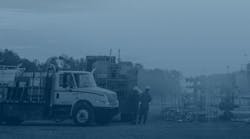Until recently, the prevailing perception of the oil and gas industry operating in emerging areas was that waste represented an unwelcome inconvenience. Because primary infrastructure was not designed to handle waste, oil company health and safety executives were assigned the task. And a general reluctance surrounded the whole issue.
Lately, however, corporate image and stakeholder interest have become driving forces as the industry responds to growing public and government awareness of environmental factors. New “grassroots” thinking is paving the way, and enterprising methods for cost-effective waste management are coming to the fore.
Effective waste management actually can help increase profitability rather than draining the bottom line.
Industry has learned the hard way that it no longer can leave the problem of handling waste to local services, which are often underdeveloped. Oil and gas companies have had to accept the duty of care and to adopt acceptable methods for disposal on site. The fines levied for non-compliance no longer can be ignored—even in some emerging markets where fines represent an income source for burgeoning local administrators.
In the process of examining what materials are used, exported, and left behind, it is possible to improve industry’s performance, particularly in emerging areas where a dearth of legislation can be used to environmental and corporate advantage.
Waste management evolving
With the right approach, it’s feasible to meet the spirit of UK, US, and European Union regulations worldwide. Formerly, contractors dealt with waste by digging a large hole and burying it, but now viable means have been developed to minimize construction refuse and to turn seismic or drilling waste into resources through recycling initiatives with zero waste going to a landfill.
A BP PLC-Sonatrach project in the mid-1990s needed to establish water services and waste management for the In Salah dry gas project and the In Amenas gas condensate field, both in Algeria.
Before starting construction on gas treatment plants and associated pipelines, BP needed to establish water and sewage infrastructure for four desert communities.
Using me as an outside consultant, BP-Sonatrach developed an environmental management system to handle the 4 kg /day/person of waste generation by more than 2,000 workers involved in the construction phase.
Amid sandstorms, extreme heat, and the threat of finding venomous snakes and spiders in the waste, BP needed to deal with waste quickly, efficiently, and cost effectively. For the In Amenas project, the design had progressed to a standalone waste management center that was devised with 20-ft containers.
A generator in a separate container supplied power to operate the equipment housed in the other containers. The waste management center was ready to use immediately, and the waste water treatment plant took 1 month to build and was used for several years, requiring minimal maintenance.
Watchwords: the 4 Rs
The watchwords of waste management—Remove, Reduce, Reuse, Recycle—depend upon supply-chain purchasing protocols, worker behavior, storage and handling methods, and strict segregation of waste types.
With everyone working to achieve good waste-management and recycling systems, the company, personnel, and local populace develop a relationship that benefits all, providing:
- A healthier site with no smells.
- A tidier site with fewer accidents.
- Fewer disease borne vectors.
- Local employment opportunities.
- Improved company image.
- Compliance with legislation, reducing the incidence of costly fines.
- Positive use of waste to create new resources.
- Huge financial and environmental savings in waste transportation.
What once might have sounded too good to be true now has been tried and proved. Projects worldwide are using simple guidelines and cost-effective equipment that reduce waste and save money for the operator.
The key issue is to establish the right thinking at the onset of each project and to ensure that approach is maintained consistently by all personnel throughout the project. That said, retrofits are by no means to be avoided. In time, engineers themselves become the site environmentalists.
The equipment and resources to handle the waste management are inexpensive to install. Their costs are recouped several times over in terms of lower waste-removal expenses.
The main objective of waste-management equipment is to reduce volume. Vehicles carrying 50-90% air—as is normally done—means higher expenses in waste trucks, labor, diesel, and increases a project’s carbon footprint.
The use of specialized equipment to break down waste into smaller volume is a quick, easy method that immediately produces massive savings on traditional waste disposal methods.
A wide range of equipment is available to treat all types of waste. Given technological advancements within the last 15 years, suppliers have grasped the difficulties, developing innovative equipment that is both mobile and versatile.
Most equipment can be delivered in a single mobile Materials Recycling Facility (MRF). This containerized unit arrives complete with everything required for a basic processing plant, ready to use on day one, powered by a generator installed in a second container if required. Once a project is finished, the MRF can be moved to the next project.
Similarly, the safe storage and transportation of chemicals from rig to rig can be handled with specially adapted ISO containers that can be moved with 24 cu m of chemicals in place. With packaging integrity protected, chemicals last longer, and the site is made safer with less danger of wind-blown contamination.
Assigning responsibilities
The question of who manages the waste on any site is a key factor. The assignment of responsibility to individuals is essential for segregation of waste at source because if wastes are mixed, the battle is partly lost. Conflicts of interest will arise if the catering contractor (who also produces waste) is solely assigned the task because the contractor’s waste operatives inevitably are coerced into taking mixed waste. Outside contractors are easier to manage, especially when it comes to transporting recyclates from the site.
Ideally, a qualified consultant instigates a system tailor-made for each project covering the following key aspects:
- Drafting the relevant parts of the tender documents and contracts to tackle waste from the beginning.
- Calculating the amount of waste expected based on manpower and project type.
- Analysis of local recyclers and waste methodologies.
- Producing a holistic waste management plan.
- Recommending equipment.
- Assisting with equipment installation.
- Training personnel on the use and maintenance of equipment.
- Providing specialist advice and solutions for handling hazardous waste.
- Incorporating waste into existing environmental management systems.
- Training engineers to become environmentally aware.
Handled well, waste management provides not so much a chore as a chance to excel, and a great advantage when a company is being audited for ISO 14001, for example, with certification process auditors increasingly looking at waste management as an indicator of overall performance. ¿
The author
Andrew Ive ([email protected]) has 36 years of wide-ranging engineering, design, inspection, and supervisions experience. In recent years, he has combined his engineering contract work for major UK companies with development of his own designs, for onshore and offshore, with patents awarded. He holds a BS in science and technology with a Higher National Certificate in mechanical engineering from Kingston College in London. Along with several postgraduate diplomas, he has charterships of the Institute of Environmental Management and Assessment and the Chartered Institute of Waste Managers. He also is certified in the IOSH safety system.





